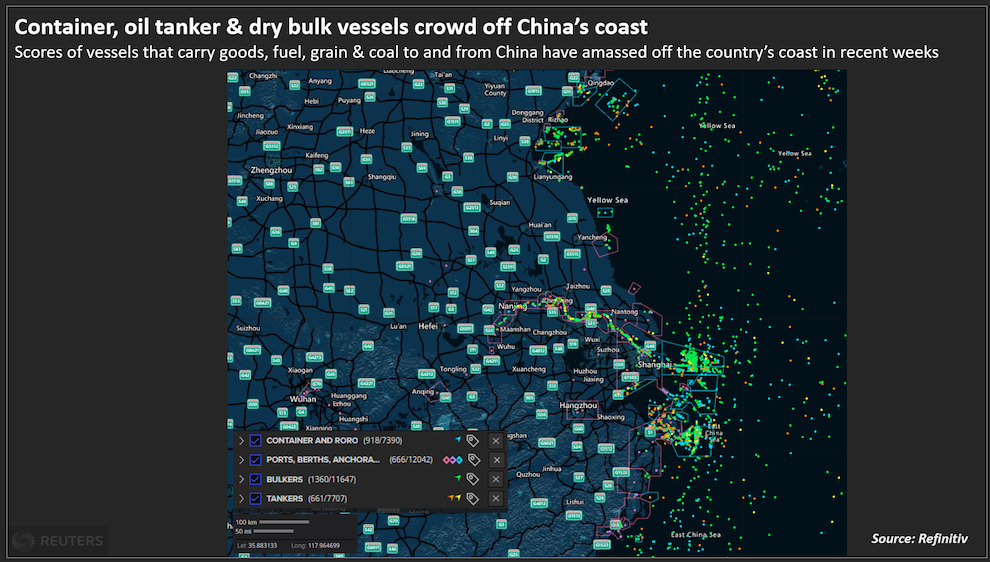China’s new data law has cast a veil over Shanghai, making it harder to gauge trade and logistics movements in the commercial hub when there is great interest in real-time data on supply chain hold-ups.
The government restricted firms from releasing real-time data, which is a big concern for trading companies and logistics managers trying to follow China’s economy.
As China’s most populous city struggles to emerge from weeks of crippling coronavirus curbs, companies can no longer see how goods are moving in and out of the key port because the data law limits data sharing.
Industrial barometers from crude oil inventories at import terminals to high-frequency container throughput at ports were widely available previously, offering a real-time window on the world’s second-biggest economy unhampered by the delays and possible distortions of official economic data.
But crucial sources of information about the world’s biggest exporting nation have gone dark since the Personal Information Protection Law came into effect in November.
Shipping companies and brokers have resorted to less accurate satellite-based tracking to monitor port delays.
Traffic data to gauge truck shipping and commerce is no longer available. Traders track port activity by phone calls or even hand-counting ships.
That lack of visibility will affect every other link in China’s globe-spanning supply chains as work gradually resumes, the flow of goods picks up and shippers seek to clear traffic jams off China’s east coast.
“We are no longer able to obtain some of the high-frequency data, like daily cargo turnover at ports, railway and air traffic passenger data,” Dong Chen, head of Asia macroeconomic research at Pictet Wealth Management, said.
“Some of the data became monthly basis only,” Chen said. “We just have to deal with what it is.”
The Cyberspace Administration of China and the Ministry of Transport did not respond to requests for comment on the impacts of the data law.

In The Dark
The data law is the latest in what accountancy giant PwC (PriceWaterhouseCoopers) calls “one of the most stringent regulatory regimes many multinationals will encounter.”
The measures limit how domestic and foreign organisations can collect and use data, affecting every company operating in China.
Organisations monitoring industrial or commercial activity in China must comply with strict rules on data classification, storage, cross-border transfers, transparency and user consent management before they may publish such data to clients.
As a result, some data providers have suspended or ceased publishing data or moved it behind pay walls.
“Everyone is writing and talking about the port congestion in China due to recent wave of Covid, but we cannot find much authentic data to assess the actual situation,” a Beijing-based oil trader said.
Two years ago when Covid swept through China at the start of the pandemic, analysts, investors and journalists turned to traffic data by Dutch mapping firm TomTom to see how lockdowns stifled mobility across major cities in the world’s most populous country.
Not now. Chinese cities are not available on the company’s free international traffic congestion page, which continues to track data for dozens of other locations globally.
“We have made the business decision to discontinue the historical and live traffic feed for Chinese cities through our TomTom Move Portal and Traffic Index website, as Chinese law on the sharing and disclosing of GPS data has been tightened recently,” TomTom spokesman Ivo Bokkerink said by email.
TomTom continues to provide data to subscribers in China, he said.
After shipping companies stopped publishing Automatic Identification System (AIS) feeds on ships in Chinese waters, traders and others who track ship movements have used satellite-based positioning data that can be less accurate than ship-to-shore AIS signals.
“I’d say last year we were talking to people a few times per month” to supplement data on supply chain developments, said Ivan Lam, senior analyst at Counterpoint Research. “But the past few weeks it’s been daily.”
Others have gone more old school.
“Real-time data-driven decision making is at the heart of what we do for a living these days, especially with supply chain issues stoking inflation fires,” said Stephen Innes, managing partner at SPI Asset Management.
“Now we are reduced to relying on folks to manually count ships outside of Shanghai and Ningbo Ports again at 7pm daily for reference points.”
• Reuters with additional editing by Jim Pollard
ALSO on AF:
China Data Laws Make Disputes More Challenging, Says Forensic Firm
China’s New Data Laws Leave Firms With More Questions Than Answers
China’s Tech Crackdown Seen Leading to State-Supervised Data Trading Markets
China’s new data security law extends sovereignty to cyberspace
China unveils data security plan, says some countries bully others























